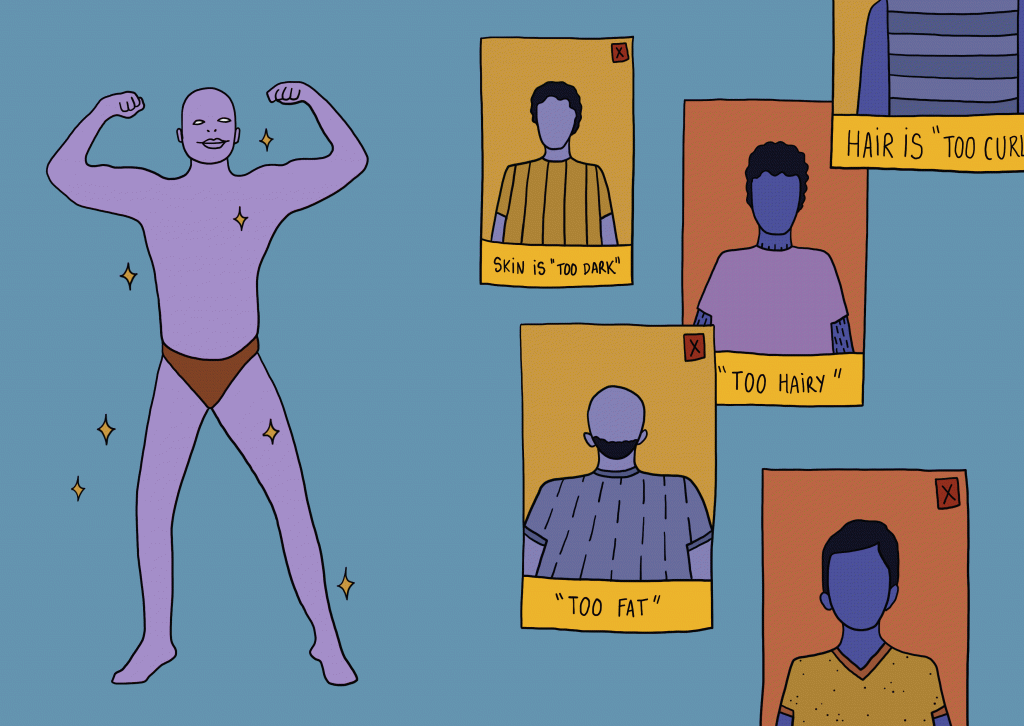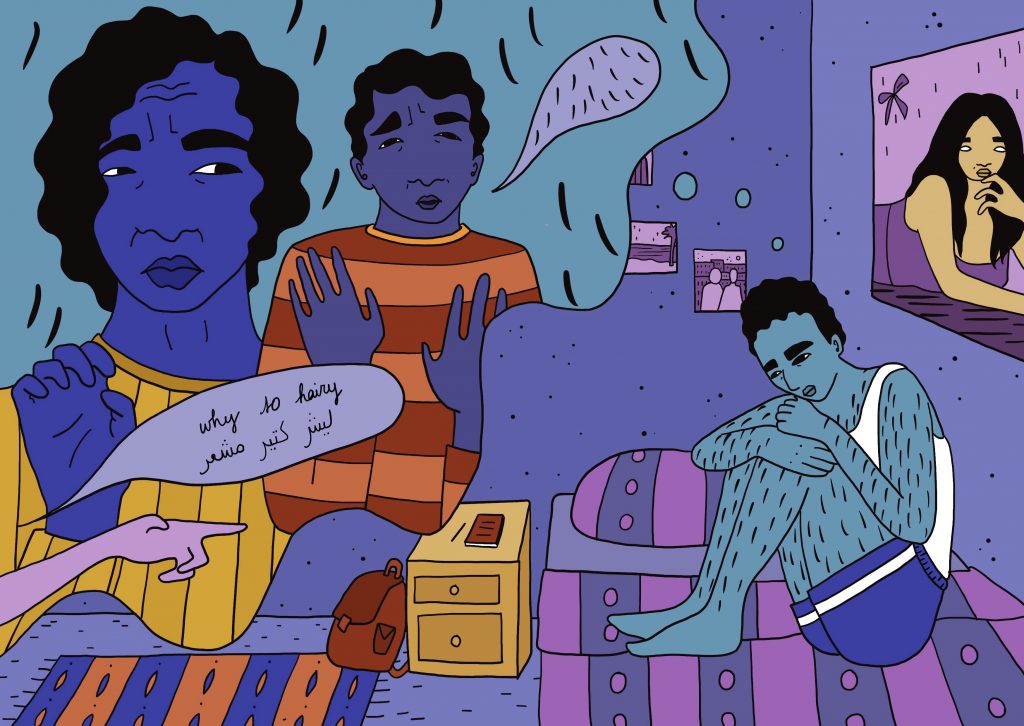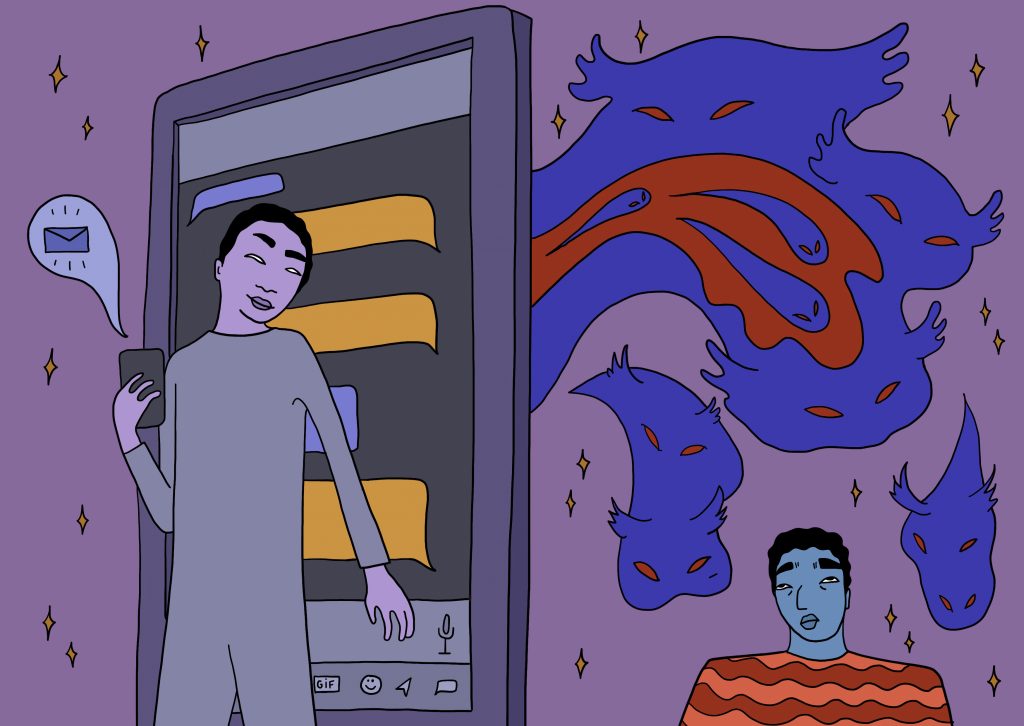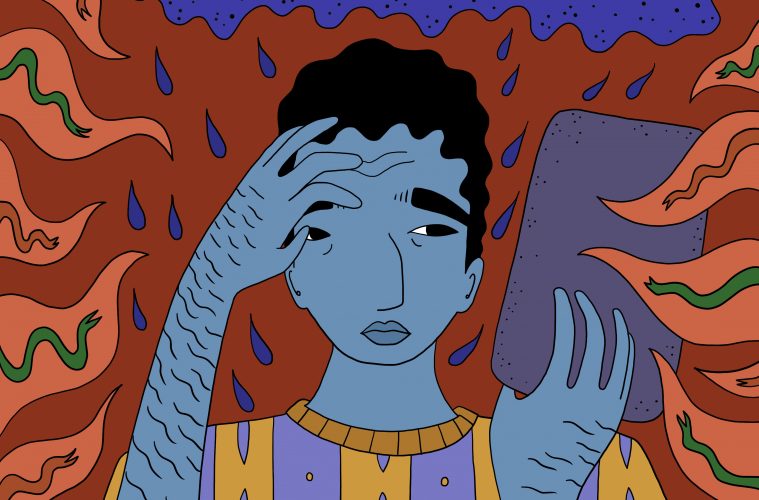By Moussa Saleh
Translated by Hiba Moustafa
Illustrations by: Aude Nasr
This article is part of the “My Hair My Hair” issue
‘A razor costs nothing, for God’s sake!’ is a statement that comes to my mind every time I talk about my body and the hair that covers it. My schoolmates would tell me this and other things about my facial hair, which started showing when I was twelve. My mustache has been visible since I was in the 7th grade, thick, soft and black bristles mixing with my dark skin and plump face, giving me sharp features that for years have made me look older than my real age.
Bullying my shape and body would have been a passing phase if I weren’t gay. These kinds of statements and hatred of me and my body, which I sometimes didn’t understand, continued when I dared to send photos to other men on Grindr.
Hair Growth and Sadness
At the age of twelve, hair began to invade my body; it was so thick that I was ashamed of wearing shorts in summer. It took me years to accept my body, which I hated, and its hair. I used to look at men around me to find only slightly hairy bodies, and even those who had thick hair over their bodies had hairless backs. I, on the other hand, had thick hair on my back and it took me lots of time and energy to accept it.
At the age of twenty, I moved to my parents’ house, where I stayed alone in a sunless room. After work and school, I would go to my room and free my body from everything that covered it. The amount of bullying I received from strange men made me reach out to my body that nobody else wanted. I would take off my clothes and go to the bathroom and rub my body hair fiercely with soap, shaping the hair into circles. I wondered why I looked like this, why my body is so big and hairy.

Illustrations by: Aude Nasr
The more I hated my body, the closer I got to it. I gave up everything – my parents, school, bully friends – and had nothing left but my body that looked so strange to other people, even my family. I remember my mum yelling at me from the kitchen whenever I went to take a bath, “Did you remove the hair that fell off your body?” I realized I was alone and had no one but myself to love. So, I dared to wear shorts all summer and go to the beach with no shirt on to cover my body hair.
However, this newfound self-love did not stop the bullying and hate messages I was receiving. I remember the night when I sent a photo of my body to some guy, and he replied, “How dare you speak to me when you’re that ugly?” I cried because I didn’t understand why a stranger would send me such hurtful words when he could’ve simply ignored me.
This is not about my body or the hair that covers it, nor is it about the rejection of hairy bodies in general. It is about the rejection of entire races, something facilitated by online dating apps that depend on speed of communication and sex acts.
Moussa Saleh
Some of the messages I receive make me think about body hair standards too. For example, when someone tells me “Your body is furry,” they expect a hairy body but not that hairy. I wonder what “that hairy” means. I think about whether I see myself as more hairy than what is permissible or customary… When I look in the mirror, I just see a hairy body with no quantity or standard.
Here, we enter a sphere of “subconscious preferences” – preferences that materialize in an image that cannot be broken unless the standards change.

Illustrations by: Aude Nasr
Hair in LGBTQ+ Community
I started to pay more attention to the dynamics of online dating between men and to understand how masculine, hairy bodies, in particular, are so hated. They are so hated that other men don’t want you to communicate with them. In the best of cases, they’ll ask you to shave your body before they agree to have sex with you.
This makes me think about my body and others with bodies like mine. Not only do we have to deal with our inner conflicts and struggles with society around our identities, but we also have to confront hatred and bullying from people whom we expect to live under the same conditions. If we zoom out, we would see that this assumption is not true.
We, in the LGBTQ+ community, are not a single group; we are people with different backgrounds and economic and social environments who are united mainly by our desire for people of the same sex as our own. We often meet through apps, the most prominent being Grindr, where people write from behind their screens – crafting their own profiles and sending mean messages without restrictions. In an article published by Jeem, “Grindr: A Space for Marginalization and Racism,” I argued that this app,
plays a prominent role in establishing sexual and gender differences and stereotypes by imposing certain categories from which participants can choose what suits them, and, in the process, stereotype users’ bodies into shameful categories and divisions. Terms like ‘No Asians,’ ‘No plumps,’ ‘No transgenders,’ ‘No blacks,’ ‘No femininity’ and ‘No hairiness,’ among others, are widespread.
When I say “restrictions,” I don’t advocate for limiting freedom of expression or communication. Rather, I hope to raise questions about how we deal with our sexualities and non-normative orientations, and how we communicate with each other via ‘white’ apps that take neither the users in our region nor the dynamics that govern us into account.
White Body Complex
Hate on dating apps doesn’t stop at my body. The problem is not personal, but rather an outcome of ideas that many gay people in our region have absorbed from pornography, which show white men with their basically smooth, soft, bulky and dominating bodies. Additionally, concepts of the white colonizers still dominate our thoughts; after surpressing the rich non-normative sexual experiences of our culture, we now look up to the West as a role model for liberation, openness, and tolerance while rejecting our hairy, non-white bodies.
Some may argue that everyone is entitled to their physical preferences, but this doesn’t necessarily lead to or justify bullying and exclusion. By thinking about the dominance of Western culture in the region and, naturally, in the LGBT+ community in the region, we can examine how identifications with the West manifest in language or the expression of queer identities. Why is it that using Arabic on dating apps can be seen as a fault of one’s character or a sign of one’s “low class”; and artworks with Arabic elements (whether it be a belly dancing outfit or Arabic songs) are seen as miraculous and daring… The audience reacts to such artworks with fascination and surprise, as if they were from a foreign culture.

Illustrations by: Aude Nasr
Rejecting body hair (among non-normative males), is not a strictly sexual preference. It often takes the form of bullying, hatred or at least rejection born of visual legacies and cultural and sexual practices that promote smooth, white body as a standard for what is beautiful and attractive. This is not about my body or the hair that covers it, nor is it about the rejection of hairy bodies in general. It is about the rejection of entire races, something facilitated by online dating apps that depend on speed of communication and sex acts.
This article is an attempt to start an ongoing discussion of the dynamics of sexual relationships among males in our region, and how Western cultural and colonial legacies that privilege whiteness shape our own preferences and choices. This is particularly significant as the debate around what is or is not racial discrimination remains vague amidst capitalism and the veneration for individualism.
Moussa Saleh is a Researcher and Facilitator. His work is centered around digital rights, online hate speech, and queer issues in Arabic-speaking countries.

